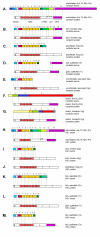Comparative genome analysis of cortactin and HS1: the significance of the F-actin binding repeat domain
- PMID: 15710041
- PMCID: PMC554100
- DOI: 10.1186/1471-2164-6-15
Comparative genome analysis of cortactin and HS1: the significance of the F-actin binding repeat domain
Abstract
Background: In human carcinomas, overexpression of cortactin correlates with poor prognosis. Cortactin is an F-actin-binding protein involved in cytoskeletal rearrangements and cell migration by promoting actin-related protein (Arp)2/3 mediated actin polymerization. It shares a high amino acid sequence and structural similarity to hematopoietic lineage cell-specific protein 1 (HS1) although their functions differ considerable. In this manuscript we describe the genomic organization of these two genes in a variety of species by a combination of cloning and database searches. Based on our analysis, we predict the genesis of the actin-binding repeat domain during evolution.
Results: Cortactin homologues exist in sponges, worms, shrimps, insects, urochordates, fishes, amphibians, birds and mammalians, whereas HS1 exists in vertebrates only, suggesting that both genes have been derived from an ancestor cortactin gene by duplication. In agreement with this, comparative genome analysis revealed very similar exon-intron structures and sequence homologies, especially over the regions that encode the characteristic highly conserved F-actin-binding repeat domain. Cortactin splice variants affecting this F-actin-binding domain were identified not only in mammalians, but also in amphibians, fishes and birds. In mammalians, cortactin is ubiquitously expressed except in hematopoietic cells, whereas HS1 is mainly expressed in hematopoietic cells. In accordance with their distinct tissue specificity, the putative promoter region of cortactin is different from HS1.
Conclusions: Comparative analysis of the genomic organization and amino acid sequences of cortactin and HS1 provides inside into their origin and evolution. Our analysis shows that both genes originated from a gene duplication event and subsequently HS1 lost two repeats, whereas cortactin gained one repeat. Our analysis genetically underscores the significance of the F-actin binding domain in cytoskeletal remodeling, which is of importance for the major role of HS1 in apoptosis and for cortactin in cell migration.
Figures




Similar articles
-
Haematopoietic lineage cell-specific protein 1 (HS1) promotes actin-related protein (Arp) 2/3 complex-mediated actin polymerization.Biochem J. 2003 Apr 15;371(Pt 2):485-93. doi: 10.1042/BJ20021791. Biochem J. 2003. PMID: 12534372 Free PMC article.
-
The coiled-coil domain is required for HS1 to bind to F-actin and activate Arp2/3 complex.J Biol Chem. 2005 Nov 11;280(45):37988-94. doi: 10.1074/jbc.M504552200. Epub 2005 Sep 11. J Biol Chem. 2005. PMID: 16157603
-
Caspase-mediated cleavage of actin-binding and SH3-domain-containing proteins cortactin, HS1, and HIP-55 during apoptosis.Biochem Biophys Res Commun. 2001 Nov 9;288(4):981-9. doi: 10.1006/bbrc.2001.5862. Biochem Biophys Res Commun. 2001. PMID: 11689006
-
Hematopoietic cell-specific lyn substrate (HCLS1 or HS1): A versatile actin-binding protein in leukocytes.J Leukoc Biol. 2019 May;105(5):881-890. doi: 10.1002/JLB.MR0618-212R. Epub 2018 Dec 11. J Leukoc Biol. 2019. PMID: 30537294 Review.
-
[HS1 and EMS1].Gan To Kagaku Ryoho. 1997 Sep;24(11):1448-53. Gan To Kagaku Ryoho. 1997. PMID: 9309140 Review. Japanese.
Cited by
-
Multi-target siRNA: Therapeutic Strategy for Hepatocellular Carcinoma.J Cancer. 2016 Jun 25;7(10):1317-27. doi: 10.7150/jca.15157. eCollection 2016. J Cancer. 2016. PMID: 27390607 Free PMC article.
-
Cortactin overexpression results in sustained epidermal growth factor receptor signaling by preventing ligand-induced receptor degradation in human carcinoma cells.Breast Cancer Res. 2005;7(6):235-7. doi: 10.1186/bcr1316. Epub 2005 Aug 25. Breast Cancer Res. 2005. PMID: 16280034 Free PMC article.
-
Quantitative shotgun proteomics distinguishes wound-healing biomarker signatures in common carp skin mucus in response to Ichthyophthirius multifiliis.Vet Res. 2018 Apr 20;49(1):37. doi: 10.1186/s13567-018-0535-9. Vet Res. 2018. PMID: 29678203 Free PMC article.
-
Control of MT1-MMP transport by atypical PKC during breast-cancer progression.Proc Natl Acad Sci U S A. 2014 May 6;111(18):E1872-9. doi: 10.1073/pnas.1400749111. Epub 2014 Apr 21. Proc Natl Acad Sci U S A. 2014. PMID: 24753582 Free PMC article.
-
Mining the potential therapeutic targets for coronary artery disease by bioinformatics analysis.Mol Med Rep. 2018 Dec;18(6):5069-5075. doi: 10.3892/mmr.2018.9551. Epub 2018 Oct 10. Mol Med Rep. 2018. PMID: 30320387 Free PMC article.
References
-
- Genecard cortactin. 2005. http://bioinfo.weizmann.ac.il/cards-bin/carddisp?CTTN&search=EMS1&suff=txt
-
- Zhan X, Hu X, Hampton B, Burgess WH, Friesel R, Maciag T. Murine cortactin is phosphorylated in response to fibroblast growth factor-1 on tyrosine residues late in the G1 phase of the BALB/c 3T3 cell cycle. J Biol Chem. 1993;268:24427–24431. - PubMed
-
- Schuuring E, Verhoeven E, Mooi WJ, Michalides RJ. Identification and cloning of two overexpressed genes, U21B31/PRAD1 and EMS1, within the amplified chromosome 11q13 region in human carcinomas. Oncogene. 1992;7:355–361. - PubMed
-
- Brookes S, Lammie GA, Schuuring E, de Boer C, Michalides R, Dickson C, Peters G. Amplified region of chromosome band 11q13 in breast and squamous cell carcinomas encompasses three CpG islands telomeric of FGF3, including the expressed gene EMS1. Genes Chromosomes Cancer. 1993;6:222–231. - PubMed
Publication types
MeSH terms
Substances
LinkOut - more resources
Full Text Sources
Research Materials
Miscellaneous

